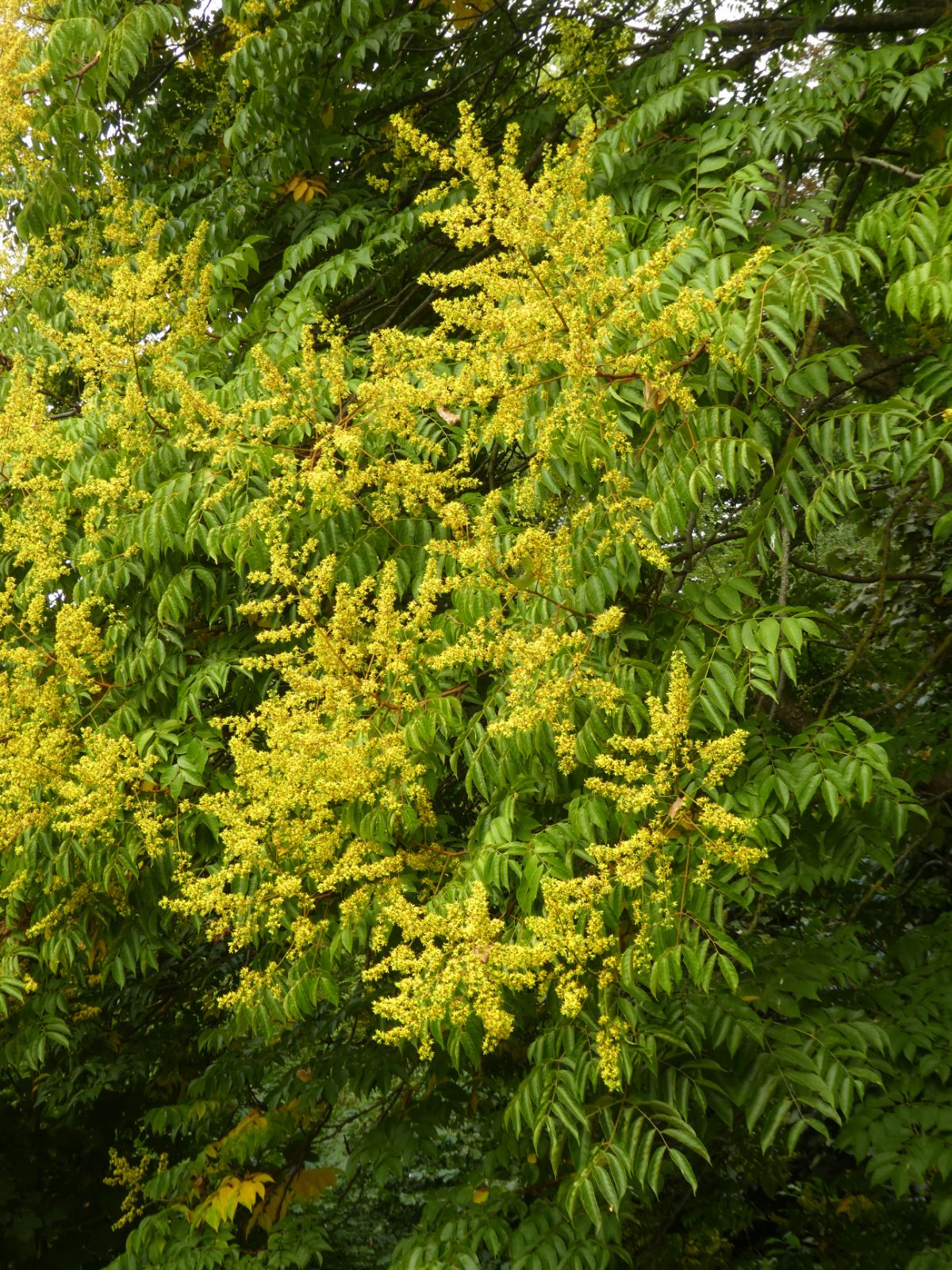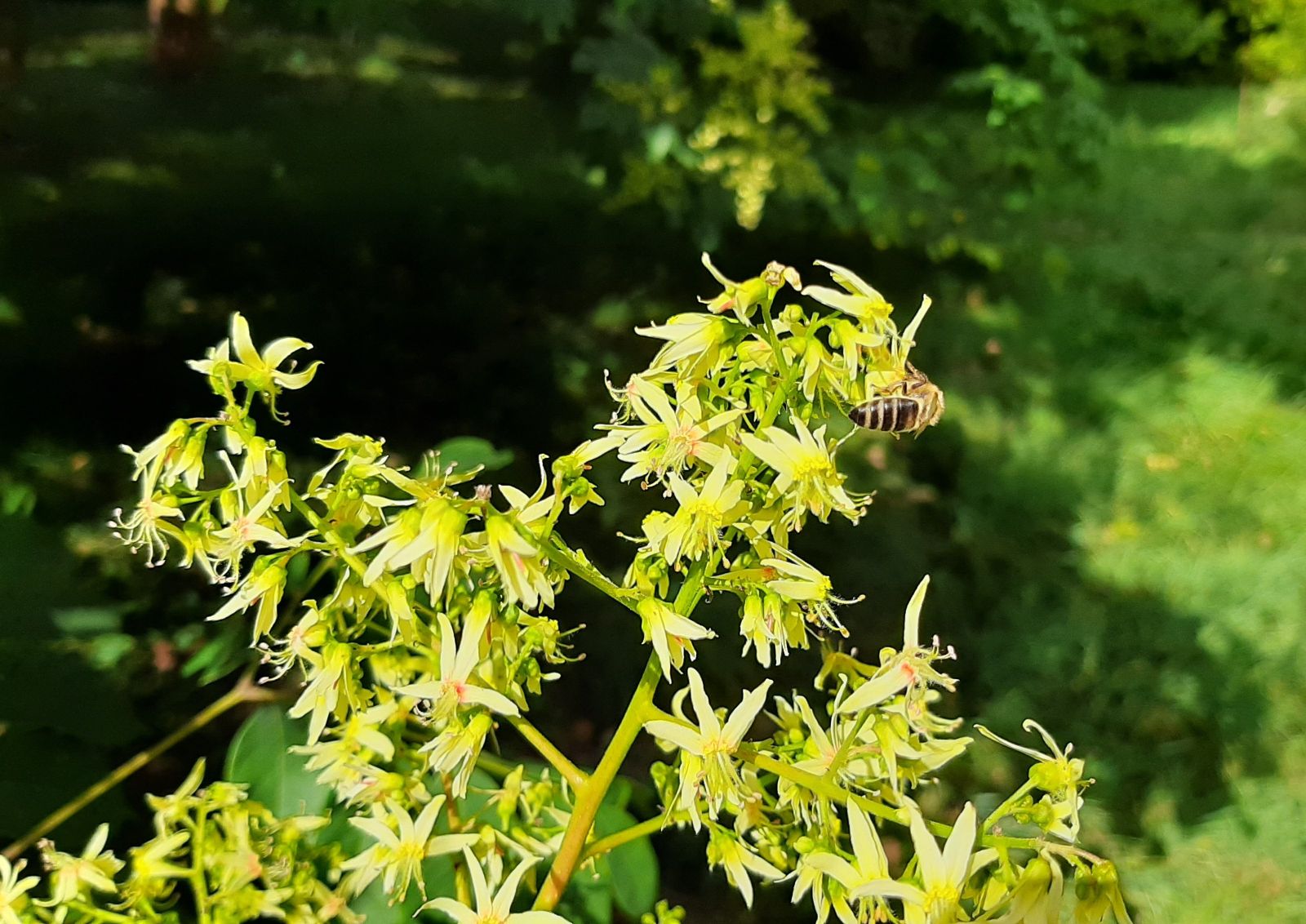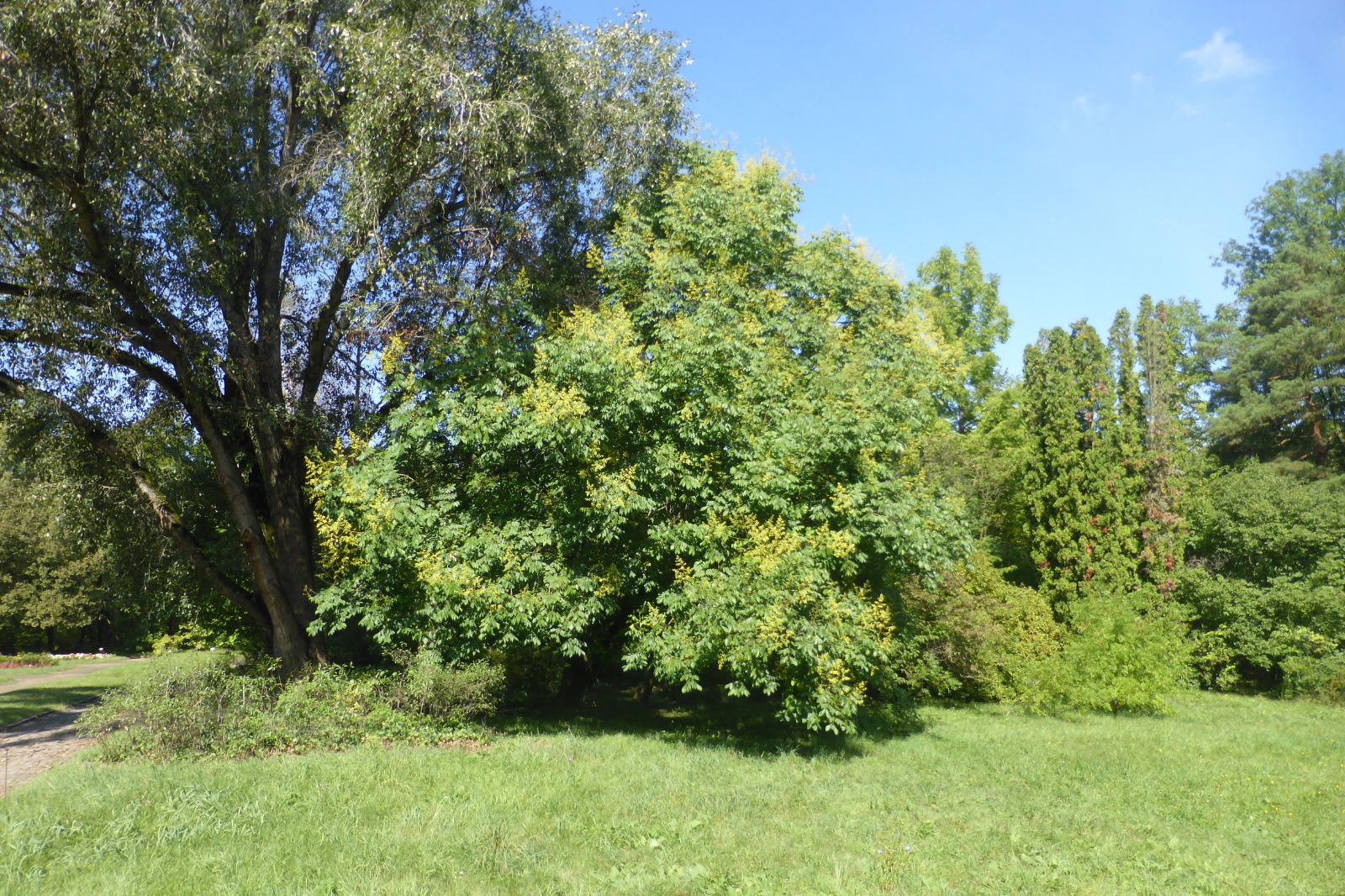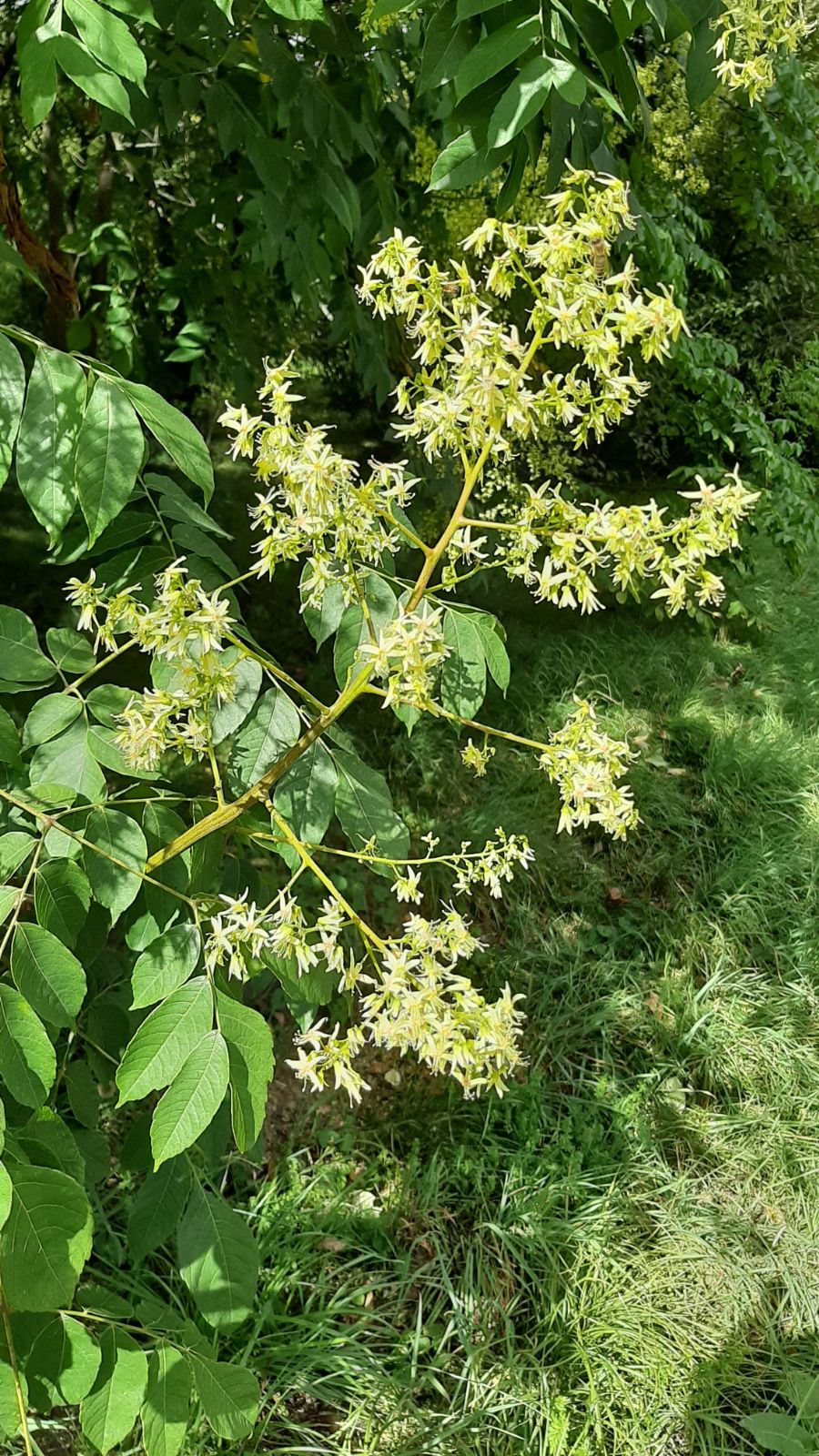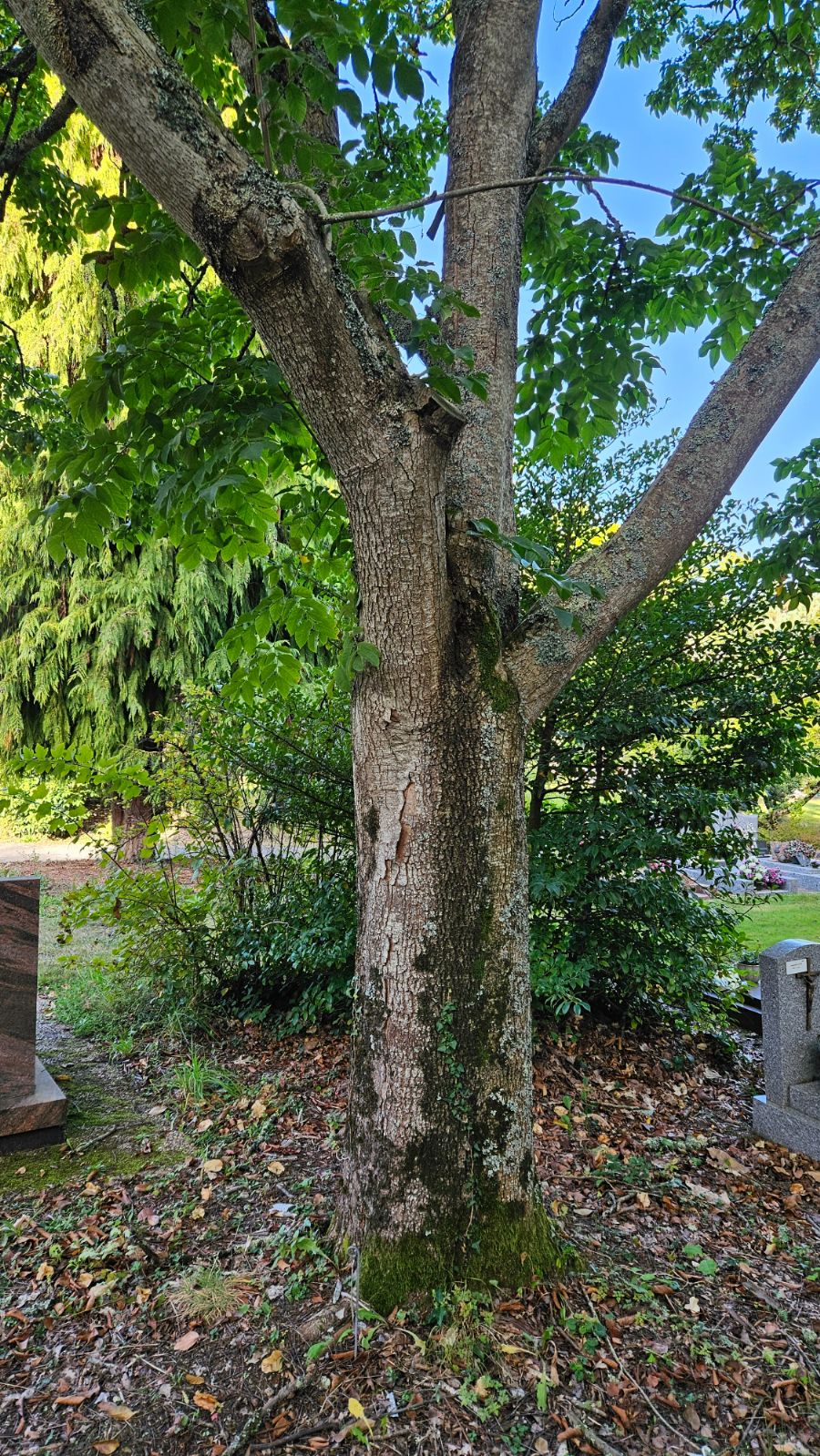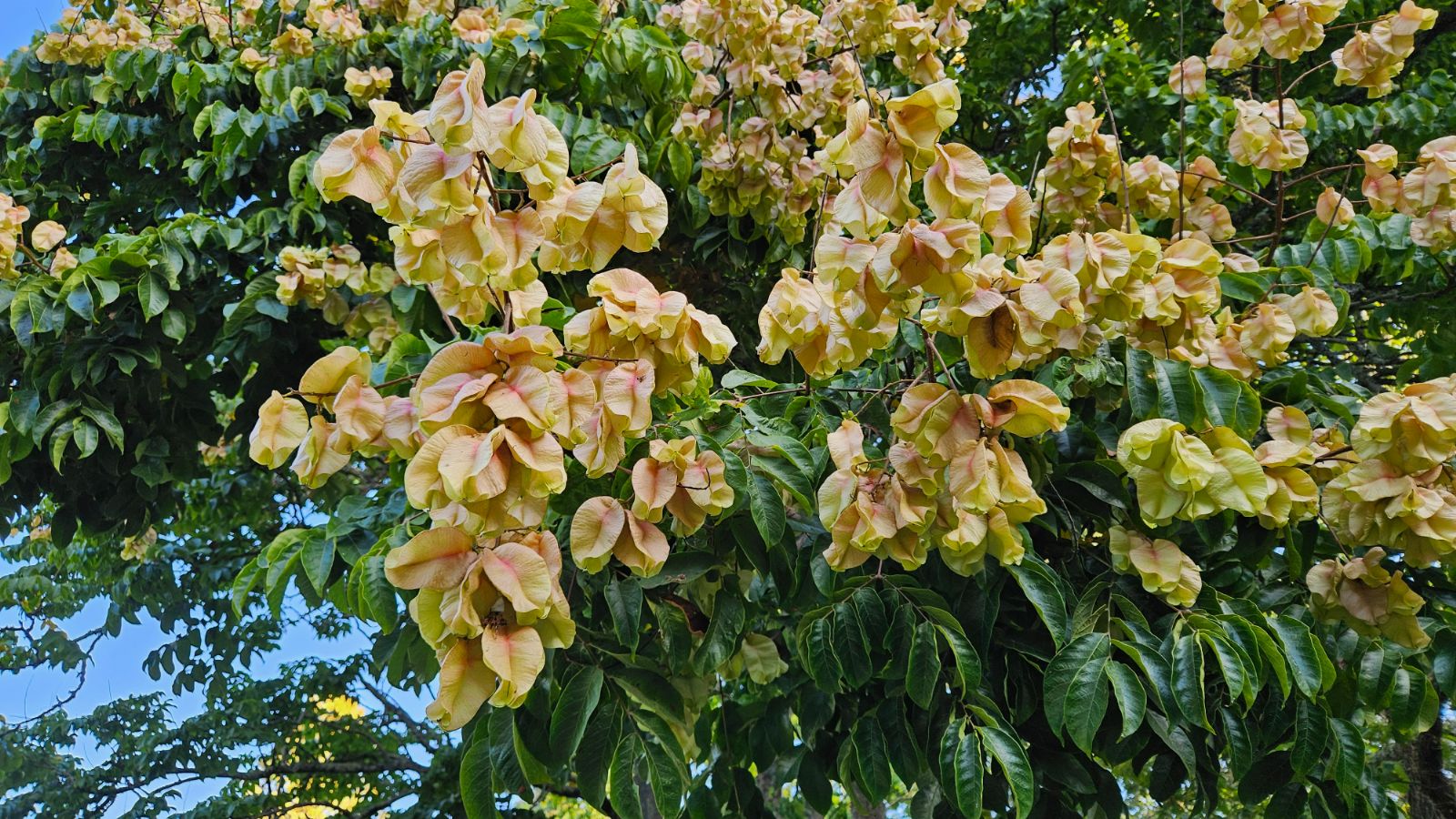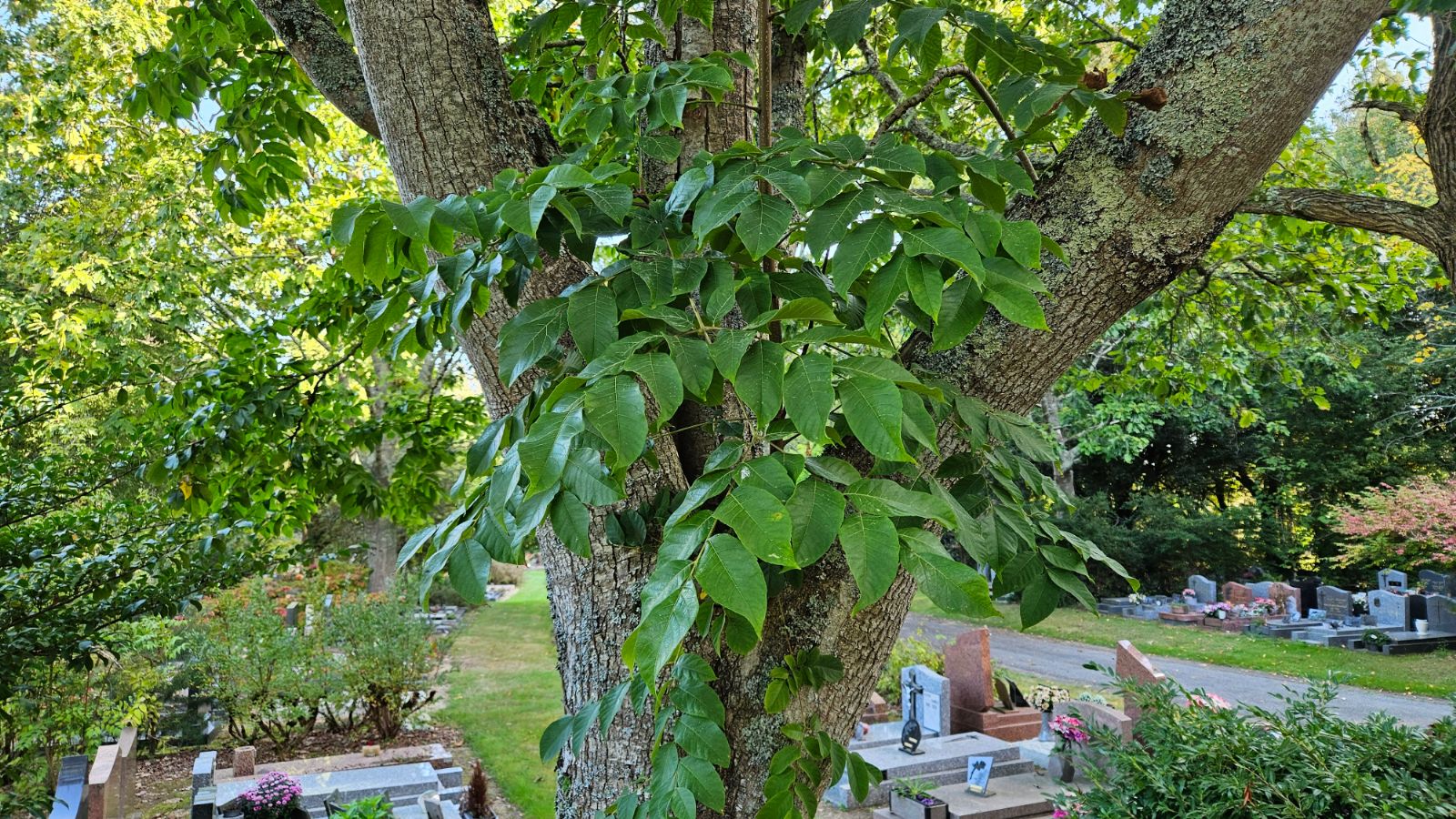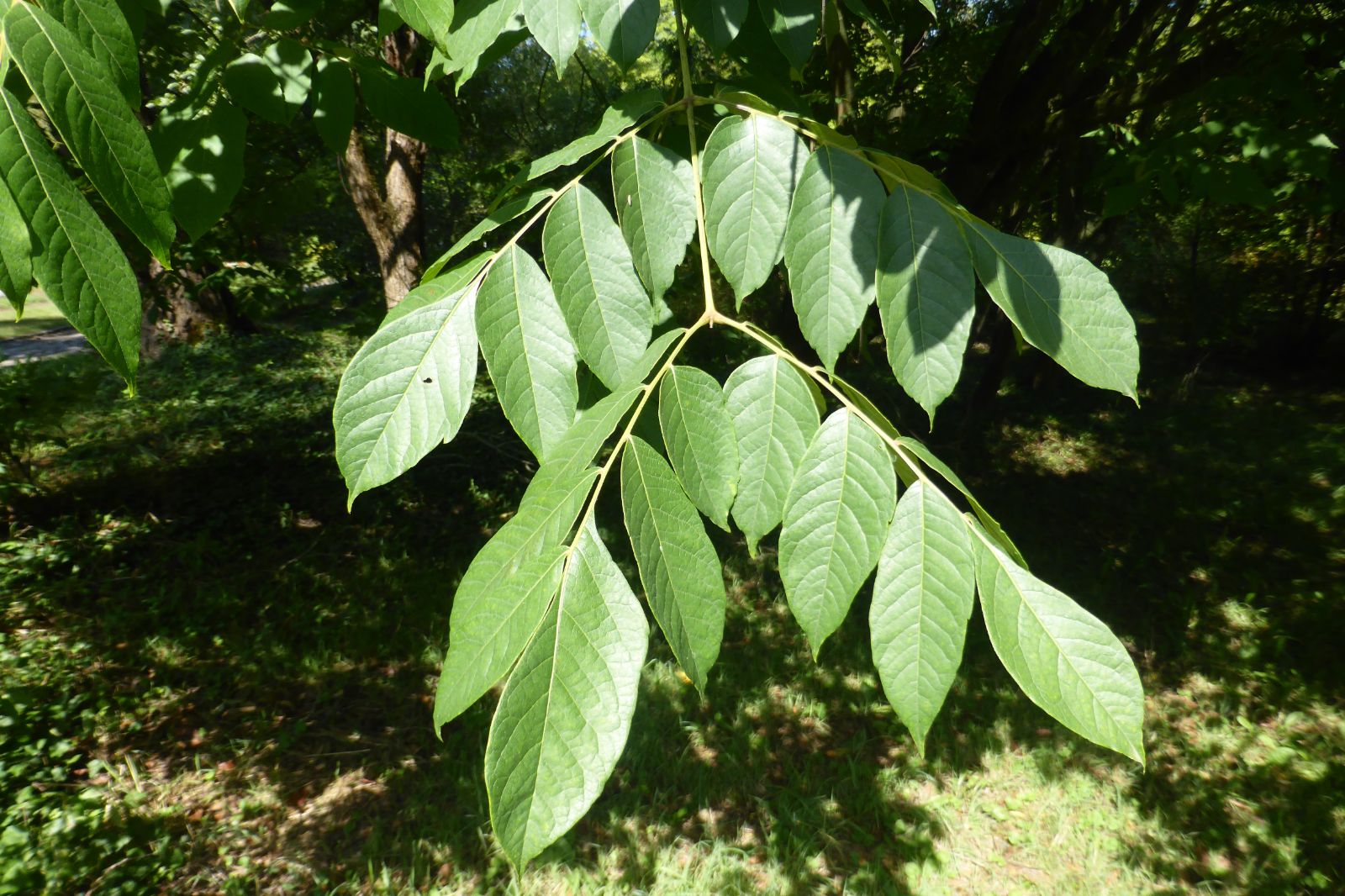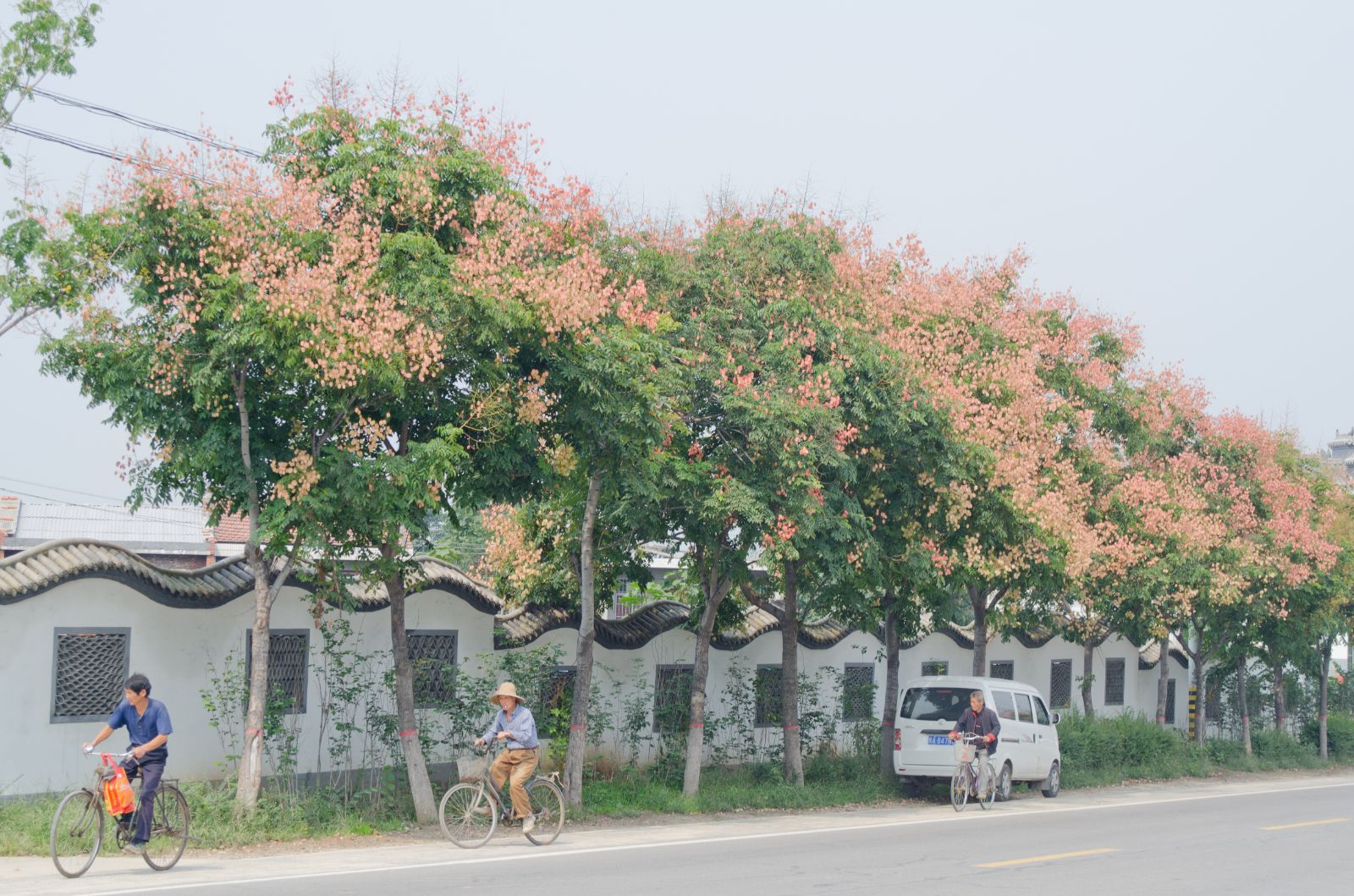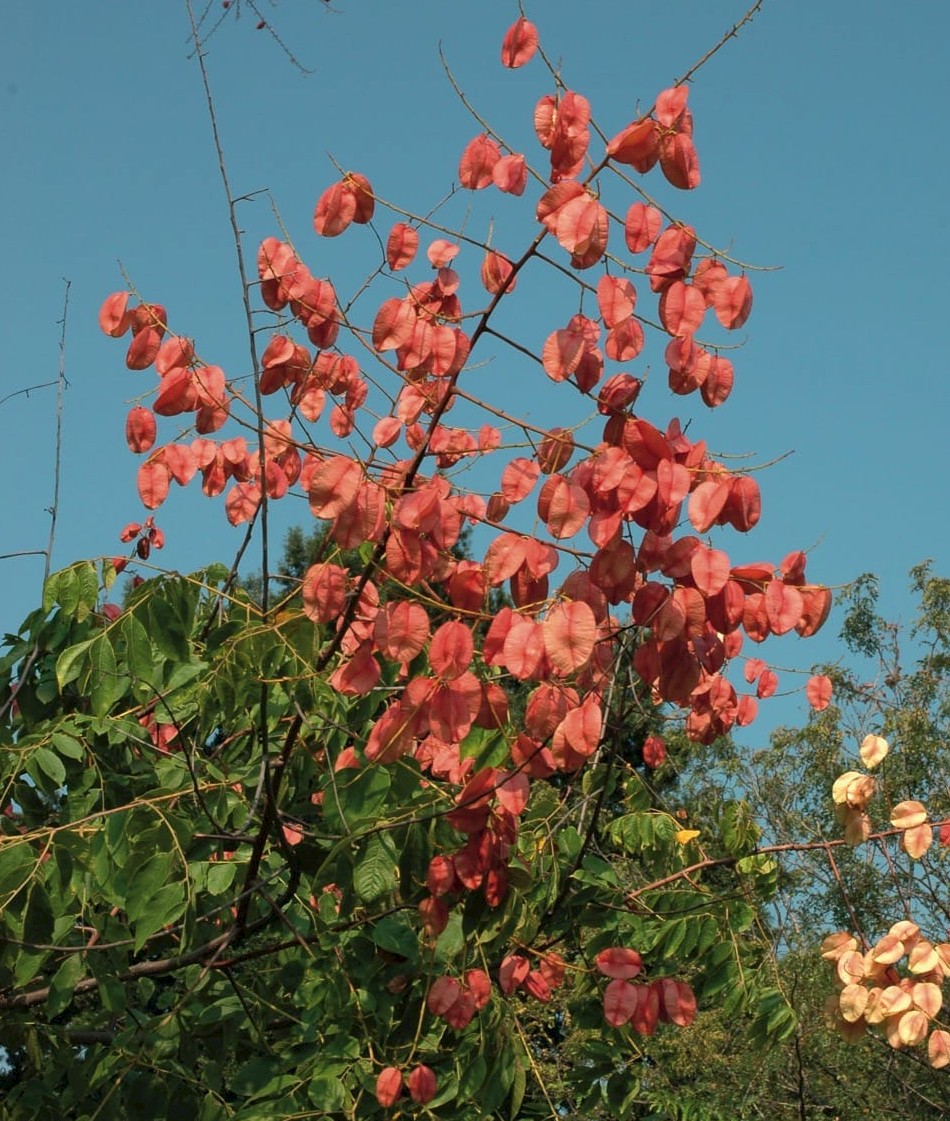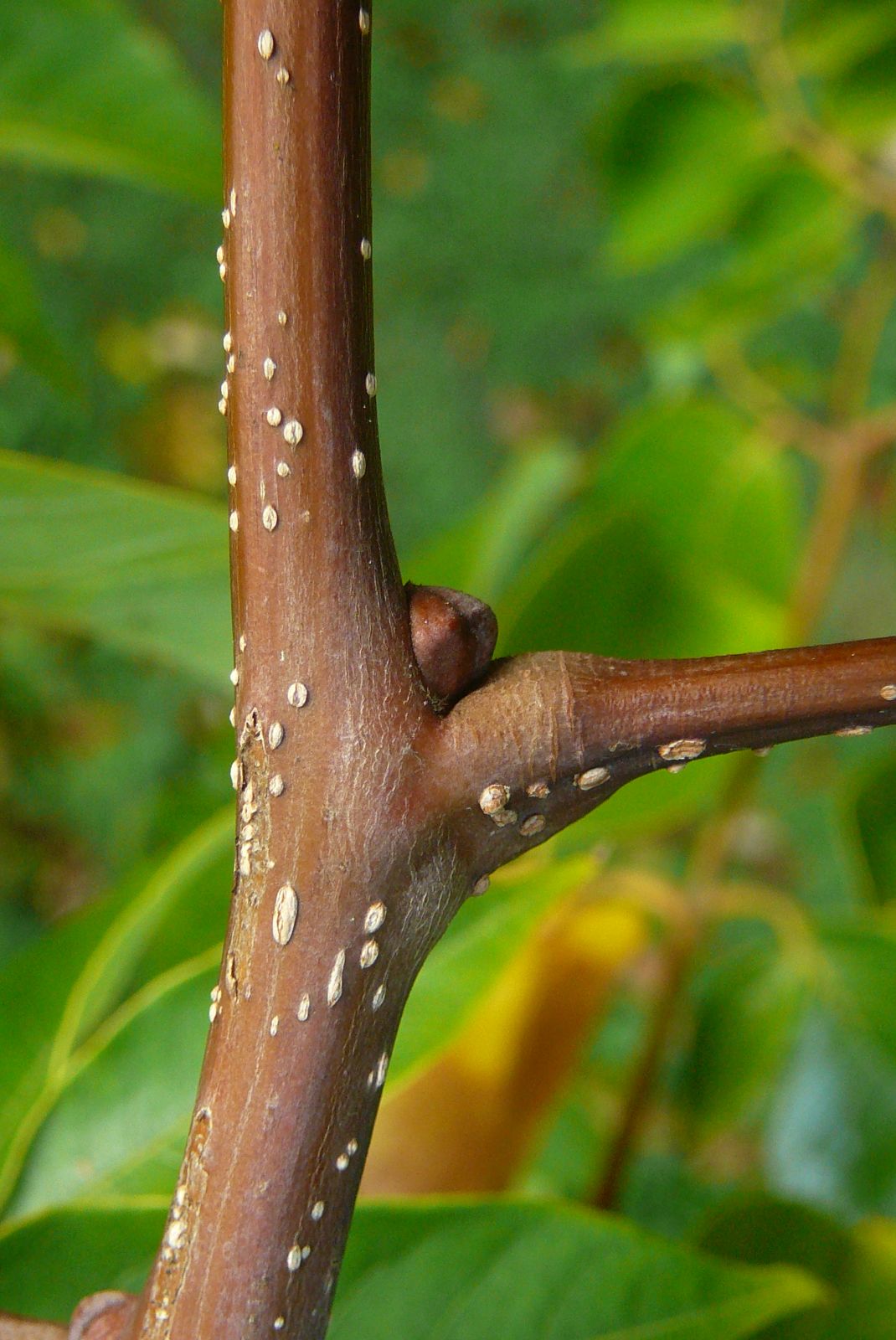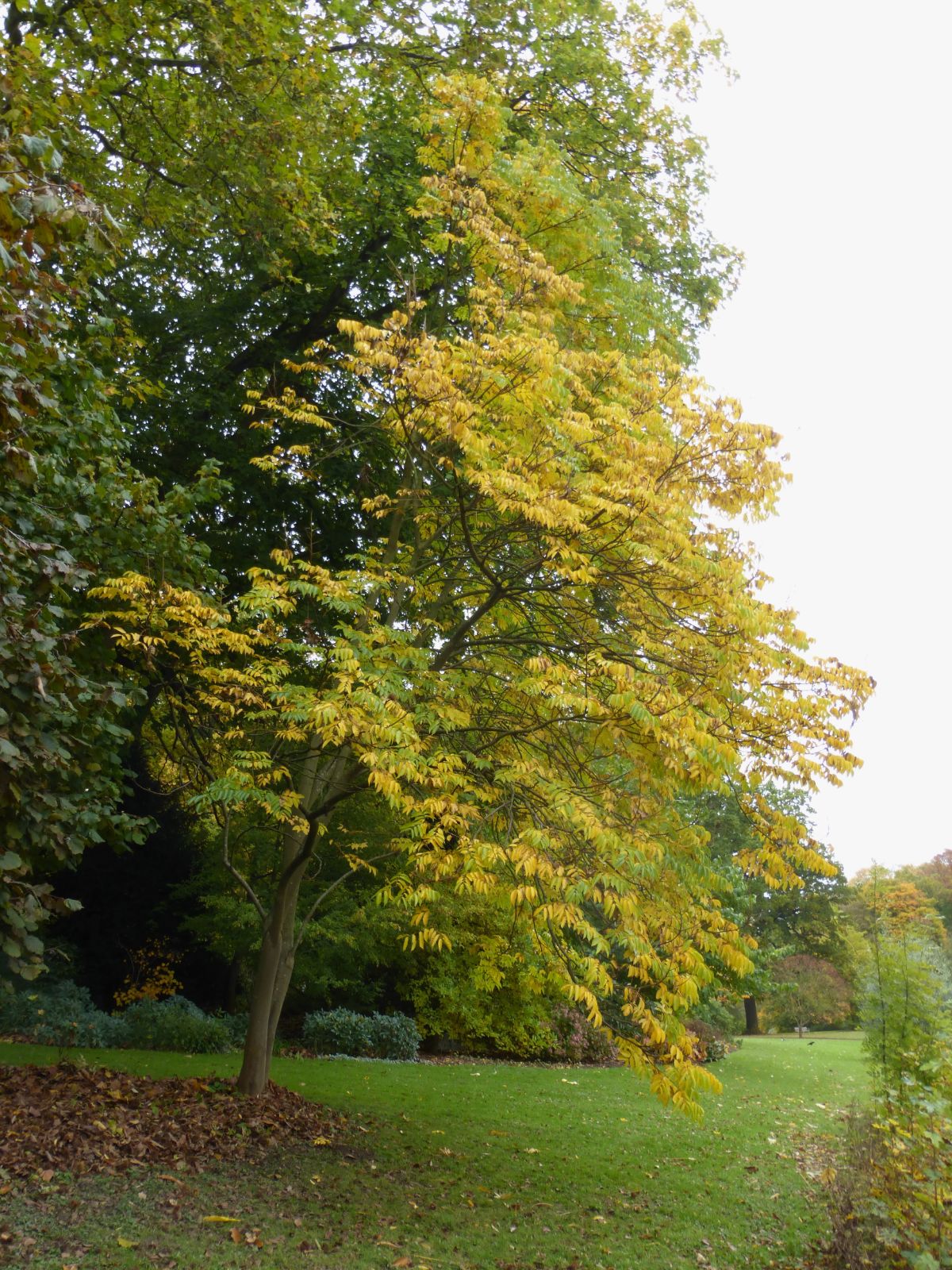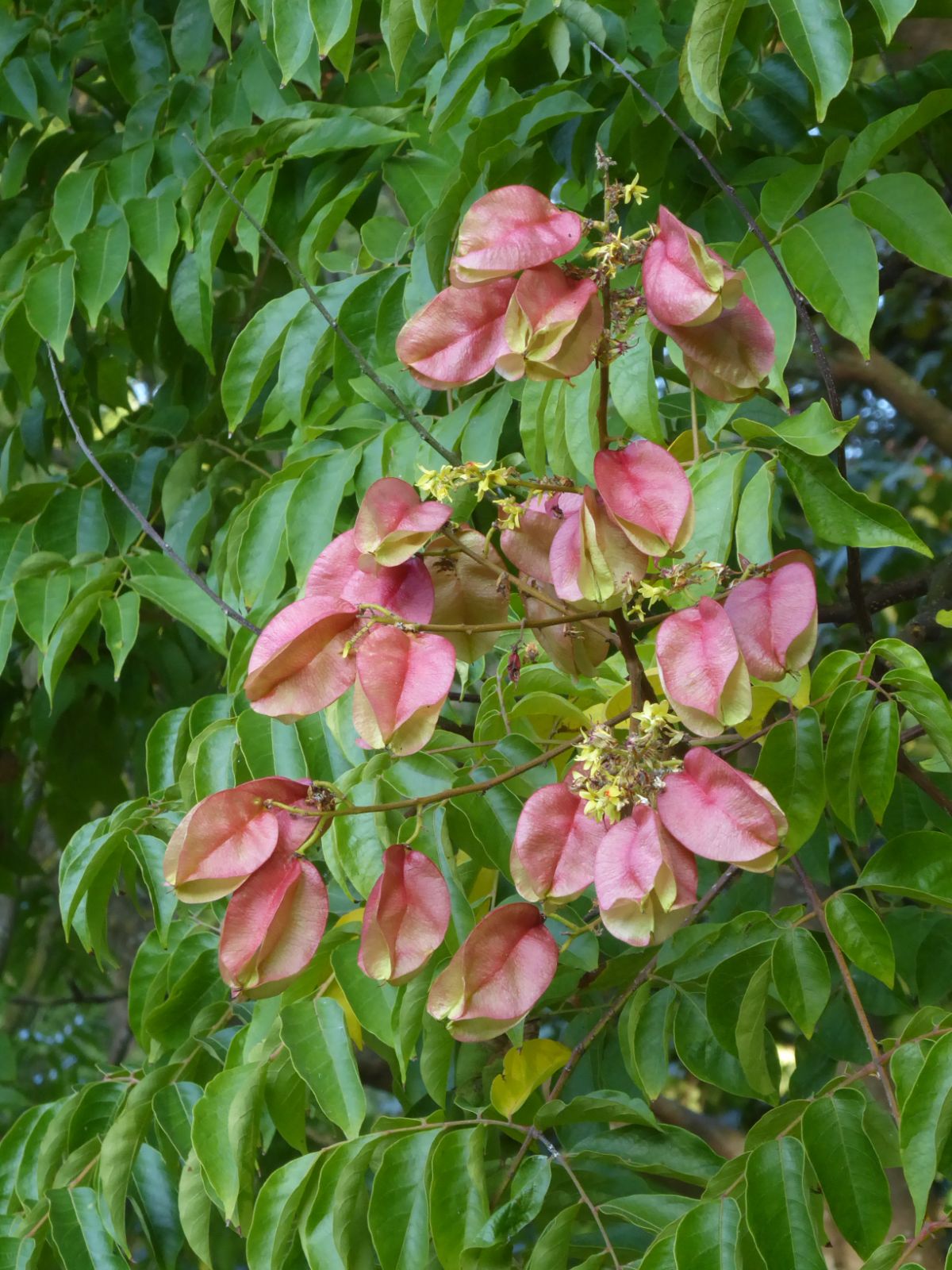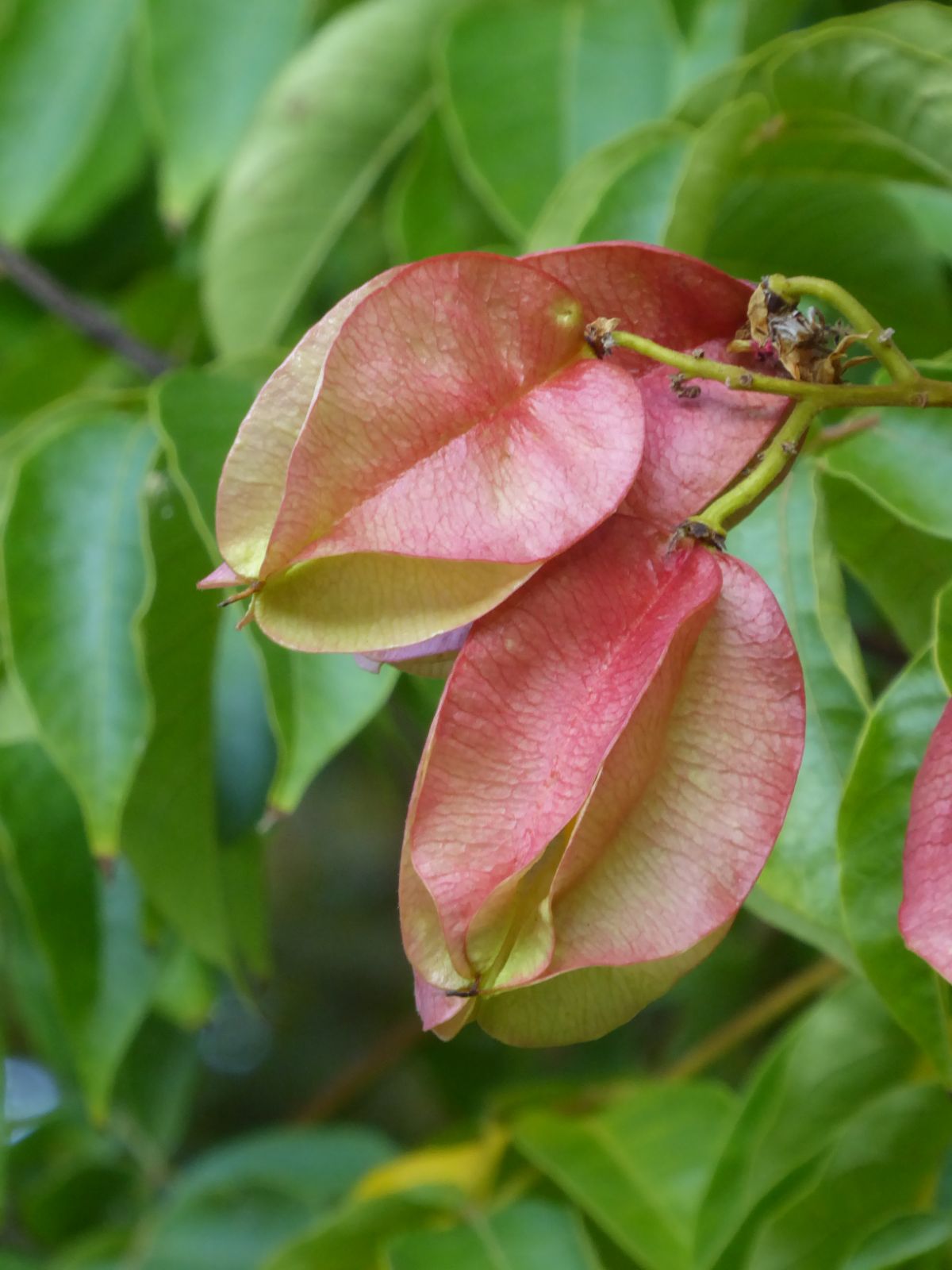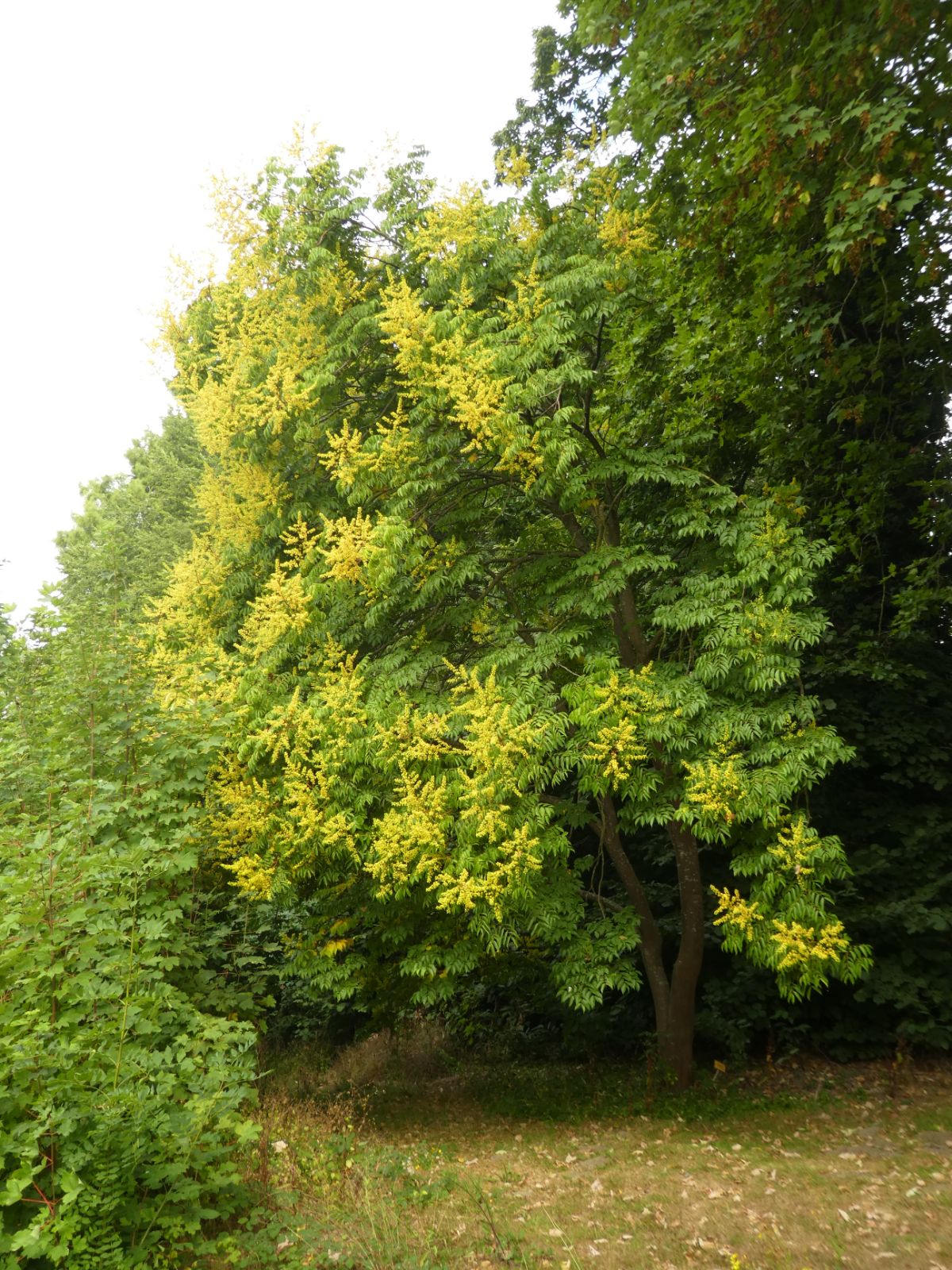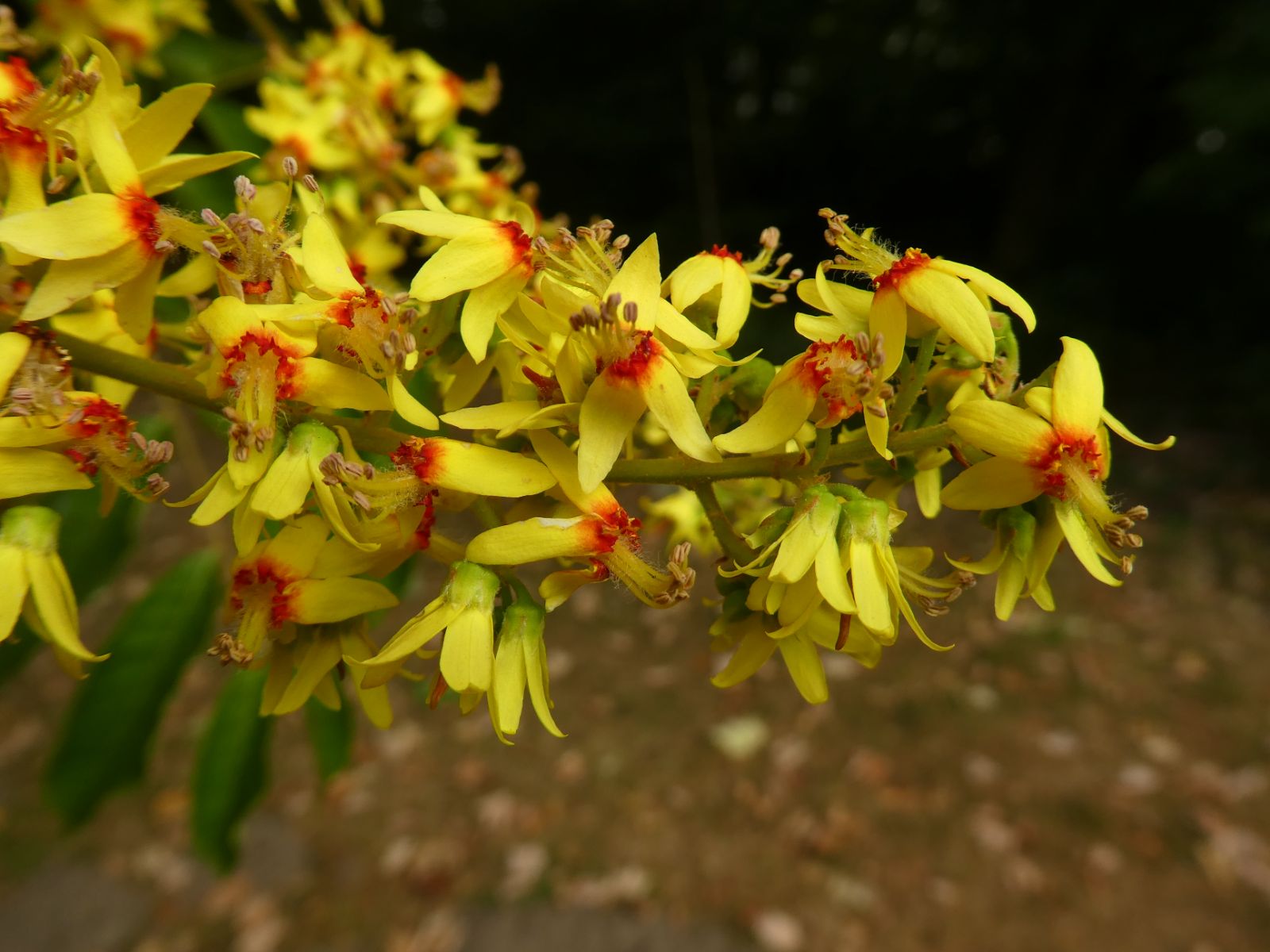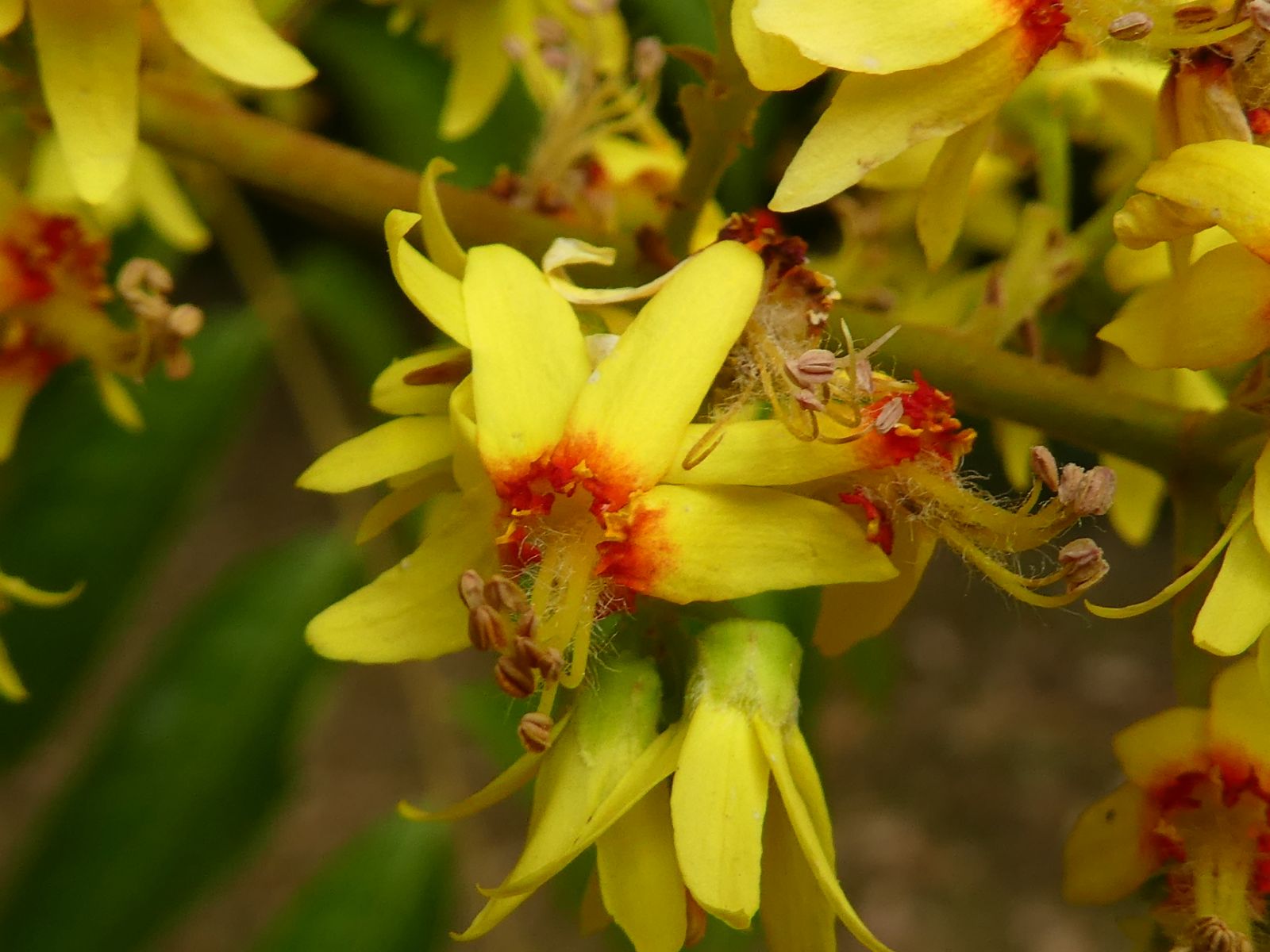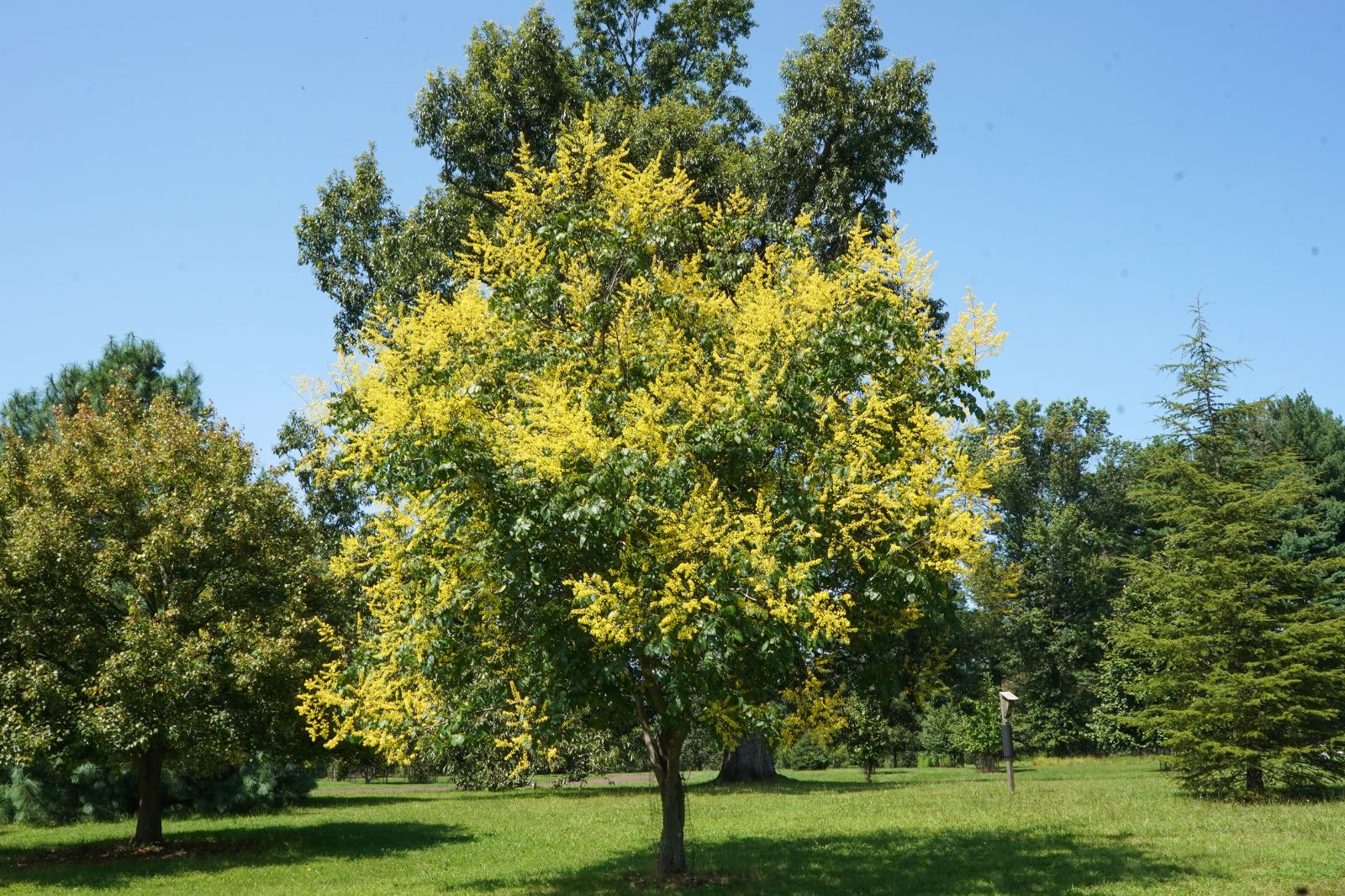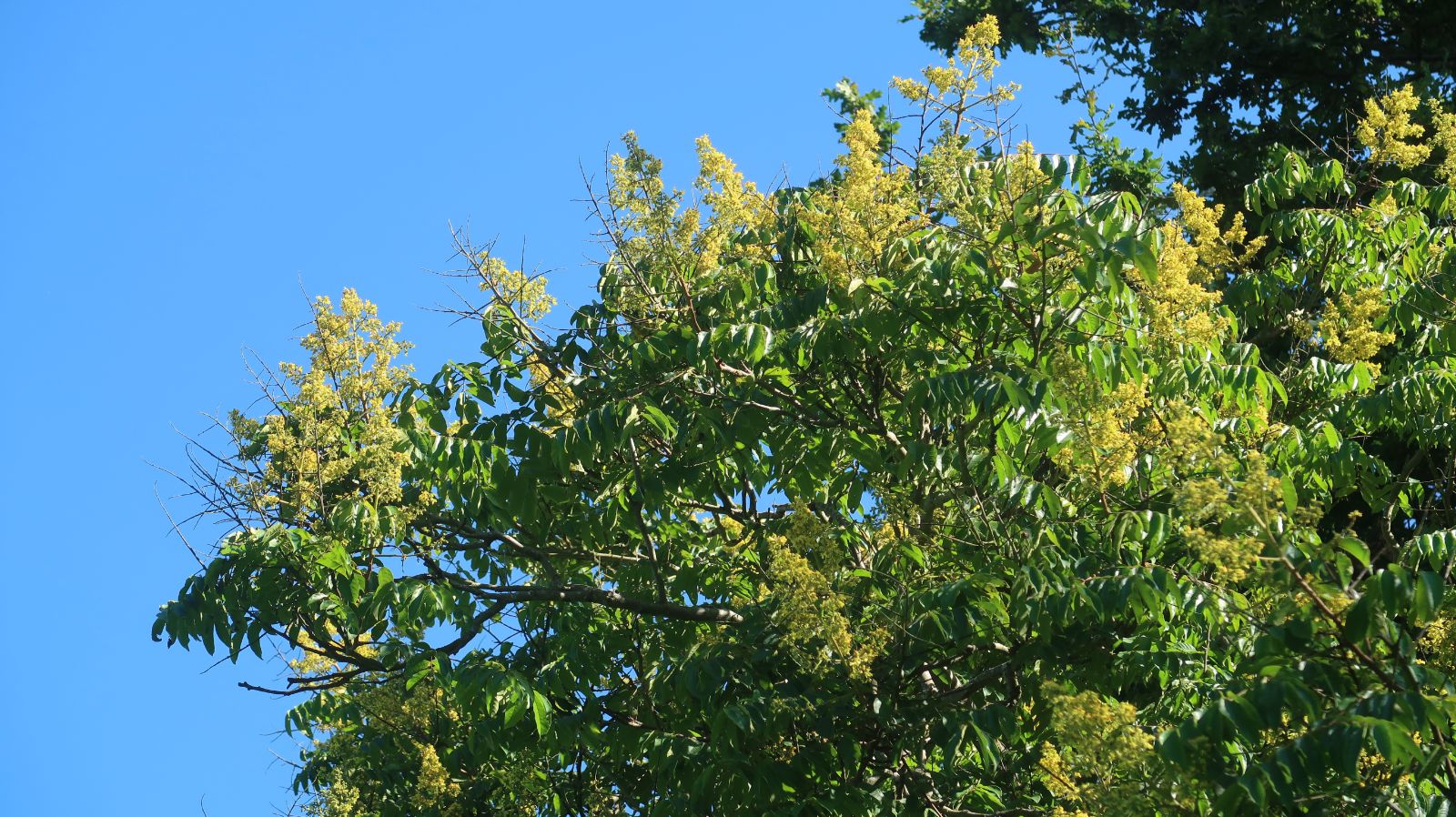Koelreuteria bipinnata
Sponsor
Kindly sponsored by
a member of the International Dendrology Society
Credits
Richard Moore (2024)
Recommended citation
Moore, R. (2024), 'Koelreuteria bipinnata' from the website Trees and Shrubs Online (treesandshrubsonline.
Genus
Common Names
- Feng-chui-kuo
- Fu Yu Yeh Luan Shu
- Hua Ch'iu Shu
- P'ao Hua Shu
- Un Tsing-pa'ko
- Shan Ts'o
- Chinese Flame Tree
Synonyms
- Koelreuteria bipinnata var. integrifoliola (Merr.) T.C.Chen
- Koelreuteria bipinnata var. puberula Chun
- Koelreuteria integrifoliola Merr.
Tree to c. 20 m tall, c. 60 cm in diameter. Mature bark brown, splitting into small square plates. Branchlets glabrous or slightly pubescent, tuberculate, lenticels spherical to elliptic, prominent and corky cinnamon-brown in colour. Leaves spreading, bipinnate, 30–70 cm long, 23–40 cm wide; rachis lined with short hairs adaxially or glabrous; leaflets alternate to opposite 9–17; petiolules c. 3 mm or subsessile, lower leaflets never pinnatisect; lamina narrowly ovate to elliptic, 3.5–7 × 2–3.5 cm, terminal leaflet sometimes narrowly obovate, base weakly oblique, cuneate to rounded, apex acute to shortly acuminate, adaxial surface dull dark green, glabrous or with short hairs on the midrib, veins prominent impressed, abaxial surface pubescent in tufts, sometimes with crispate hairs and glands, rarely glabrous, margins entire to uniformly serrate except at base. Inflorescence a thyrse 35–70 cm long, 20–40 cm wide, densely pubescent, occassionally glandular; pedicels 2–3 mm long, lightly pubescent. Flowers; calyx lobes 5, ovate, obtuse to deltoid, fimbriate-glandular or glabrous or lightly pubescent on outer surface; petals 4, oblong-lanceolate, 6–9 mm long, 1.5–3 mm wide, apex obtuse or acute, basal appendages (scales) deeply 2-lobed, undulate, claw 1.5–3 mm long, upto twice as long at calyx lobes, densely villous mainly on margins and at base. Stamens 8, 4–7 mm long, exserted; filaments sparsely villous haired; anthers shortly-sparsely pubescent, grey to black in colour. Ovary trigonous-ellipsoid, pilose. Capsules ellipsoidal, 3.7–6.6 cm long 3–5 cm wide, valves elliptic to rounded, placenta continuous and nonwinged, inner surface lustrous, outer surface reticulate veined, rose-purple when young, with scattered hairs on middle of valves, maturing to brown. Styles 3–4.5(–6) mm long. Seeds almost spherical 5–6 mm in diameter, dark brown in colour. 2n = 32. Flowering July–September, fruiting August–October in situ. (Meyer 1976; Xia & Gadek 2007; Urdampilleta, Ferrucci & Vanzela 2005).
Distribution China Anhui, Guangdong, Guangxi, Guizhou, Hubei, Hunan, Jiangsu, Sichuan, Yunnan, Zhejiang Vietnam Sơn La
Habitat Open fields, hillside forests, thickets and roadsides from 250–2600 m asl.
USDA Hardiness Zone 5
RHS Hardiness Rating H5
Conservation status Least concern (LC)
Koelreuteria bipinnata is a very elegant species of exotic appearance, as the name suggests bearing large bipinnate leaves, quite unlike the pinnate leaves of the more familiar K. paniculata. Like K. paniculata it is native to China and Northern Vietnam and is found in similar habitats, but with a more southerly distribution. This species is very distinct from K. paniculata forming a tall, upright tree typically more slender in shape. The flowers of this species are superfically similar to those of K. paniculata with only minor differences; however, the capsules are markedly different, more rounded in shape with more strongly divided valves. Whilst young the capsules of K. bipinnata are a beautiful rose-purple colour creating a spectacular autumn display, one of the many features of this species that make it such an appealing ornamental tree. Later in the autumn further interest is provided as the foliage turns attractive shades of yellow before dropping (Meyer 1976; Sargent 1916; Naturalis Bioportal 2024).
Although Koelreuteria bipinnata is easily distinguishable from K. paniculata, its less common relative K. elegans is much more similar and the two are more easily confused with each other, especially in cultivation. In the wild the two are clearly separated geographically and so can be identified by their location alone; however, they do have many morphological similarities. K. bipinnata can be most easily distinguished from K. elegans by its more weakly oblique leaflets, less strongly acuminate apex, dull-green above with clear venation; flowers with more strongly glandular calyx lobes and typically bearing 4 petals, (whereas 5 petals are often found on K. elegans subsp. formosana) (Meyer 1976).
Koelreuteria bipinnata was first described by Adrien René Franchet in 1886 from herbarium specimens collected by Père Jean Marie Delavay in 1870 from Yunnan, China, noting it as a beautiful tree, very different to K. paniculata by virtue of its bipinnate leaves with finely toothed and completely glabrous leathery leaflets (Franchet 1886). In 1922 Elmer Drew Merrill published a new species K. integrifoliola based on a specimen collected in Guangdong Province, China in 1921, with entire leaflets rather than serrate; however, it has since been found that both trees with serrate and entire margined leaflets can be found across its range with some individuals bearing both entire and serrate leaflets on a single branch, often not well displayed on dried specimens, and Merrill’s species has long been lumped within K. bipinnata. It has further been observed that some juvenile specimens in cultivation which first produced entire leaflets later produced serrate leaflets with age suggesting that this feature is merely one of developmental timing (Merrill 1922; Meyer 1976). Owing to the relative variability of this species in the wild the later varietal ranks (K. bipinnata var. puberula Chun and var. integrifoliola (Merr.) T.C.Chen) are equally no longer accepted and were originally published to distinguish between forms bearing pubescent branchlets and those bearing entire leaflets as previously explained. Despite the evidence that K. bipinnata var. integrifoliola (Merr.) T.C.Chen is synonymous with K. bipinnata a recent paper argues that they should be distinguished based on a number of minor floral developmental differences, although whether the slight differences identified truly warrant its taxonomic separation when considering all other existing morphological variables within the species is doubtful (Cao et al. 2018).
Traditionally in China the dried flowers of this species have been used in herbal medicines for the treatments of eye related diseases with recent research showing that extracts from the leaves possess antioxidant activity. Its wood is also utilised for furniture production, while the seeds are used to make Buddhist rosaries and it has a long history of being cultivated for its ornamental value, more recently in urban landscaping due to its tolerance of drought and pollution (Lyu et al. 2017; Lyu et al. 2020). It is likely that this species shares many of its traditional uses with that of Koelreuteria paniculata in areas where both species can be found.
Although seeds were first introduced by Delavay from Yunnan in 1887 they unfortunately didn’t survive in France. According Kew’s Hand-List of Trees and Shrubs Grown in Arboretum (1894) however, Koelreuteria bipinnata was being grown there at that time. This is the earliest record of it being grown in the UK and this material is likely of Delavay’s introduction. Meyer notes that K. bipinnata was later offered at least once in commerce by Simon-Louis Frères in 1908 (Meyer 1976). One of the oldest records of this species growing in continental Europe is from La Mortola in the comune of Ventimiglia, Italy, documented to have been grown from seed sent by Henry Correvon of Geneva, Switzerland, in May 1893 with records showing the presence of the species in 1912, with seed made available in the 1911 Index Seminum (Mariotti & Zappa 2022). K. bipinnata was first introduced to the United States in 1911 by Dr Francesco Franceschi with records of it being grown in Santa Barbara, California where trees became established and are noted to have self-seeded, later being planted as street trees (Riedel 1957).
Koelreuteria bipinnata is now relatively frequent in American horticulture and offers an interesting alternative to the more commonly grown K. paniculata. Its late flowering, usually well into September, lends this species particular value and Dirr (1998) says, it ‘shines like a yellow star’ adding interest to the end of summer when little else is flowering, and the first days of autumn when leaf colouration is generally yet to start (Grimshaw & Bayton 2009). The tallest specimen seen by John Grimshaw during research for New Trees was one planted in 1979 at the US National Arboretum, 15–16 m tall in the early 2006 when it was ‘very elegant and shapely’. The species is fully hardy on the East Coast at least as far north as Philadelphia (Meyer 1976) and possibly further. Writing in the early 20th century Bean (1981) stated that the species was not hardy in London or Paris, but there are now 8 m trees growing at Kew, introduced as wild source seed collected in Zhejiang Province, China donated by the Chinese Academy of Forestry in 1979 (pers. obs.), and at Windsor, and smaller examples in a scattering of UK collections, including RHS Garden Rosemoor (6 m in 2017), Sir Harold Hillier Gardens (6.2 m in 2018), and White House Farm (5 m in 2019), the latter from MF 601 (Tree Register 2024). There are fine specimens in many continental European collections, including one of c. 9 m at Arboretum Cimetière Parc, Nantes (T. Christian pers. comm. 2024) and another in the strongly continental climate of Vácrátót Botanical Garden, Hungary (TC pers. comm. 2024). These examples all suggest that lack of summer heat, rather than cold, was probably the limiting factor in Bean’s time.
Hybridisation between Koelreuteria bipinnata and K. paniculata has been achieved in cultivation (Santamour Jr & Spongberg 1996) but while the resulting plants – planted at the United States Depertment of Agriculture Station in Glenn Dale, Maryland – exhibited hybrid vigour they did not exhibit the desired characteristics; it was hoped the cross would provide a more upright tree like that of K. bipinnata but with the hardiness of K. paniculata in addition to producing attractively coloured capsules like that of K. bipinnata. No known hybrids or cultivars of K. bipinnata are currently in cultivation.

